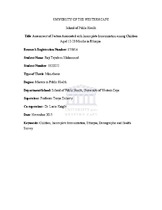| dc.description.abstract | Ethiopia has achieved its target for Millennium Development Goal 4 by recording 69 %reduction in its under-five mortality. The proportion of fully immunized children in Ethiopia has increased from 14 % in 2000 to 24 % in 2011. Though progress has been made, about 3 out of 4 children still remain incompletely immunized. The purpose of this study is to determine the socio-demographic and socioeconomic factors associated with incomplete immunization among children aged 12-23 months in Ethiopia. This study is based on secondary analysis of the 2011 Ethiopia Demographic and Health Survey. Information on 1,889 mothers of children aged 12–23 months were extracted from the children dataset. Records from vaccination cards and mothers’ self-reported data were used to determine vaccine coverage. The association between child immunization status and determinants of non-utilization of immunization services was assessed using bivariate and multivariate analyses. The findings of this study showed that the prevalence of incompletely immunized children is 70.9%. Children of mothers from the poor (AOR = 2.27; 95 % CI: 1.34 – 3.82) wealth quintile were more likely to be incompletely immunized. Children of mothers from Affar (AOR = 15.80; 95 % CI: 7.12 – 35.03), Amhara (AOR = 4.27; 95 %CI: 2.31 – 7.88), Oromiya (AOR = 8.10; 95 % CI: 4.60 – 14.25), Somali (AOR = 4.91;95 % CI: 2.65 – 9.10), Benishangul-Gumuz (AOR = 4.20; 95% CI: 2.34 – 7.57),Southern Nations Nationalities and Peoples’ (AOR = 4.76; 95 % CI: 2.53 – 8.94), Gambela (AOR = 7.75; 95 % CI: 3.68 – 16.30) and Harari (AOR = 3.22; 95 % CI: 1.77 –5.89) regions were more likely to be incompletely immunized. Mothers with inadequate exposure to media (AOR = 1.60; 95% CI: 1.21 – 2.14), who are not aware of community conversation programme (AOR = 1.80; 95% CI: 1.40 – 2.32) and who attended no antenatal care (AOR = 2.21; 95% CI: 1.72 – 2.83) were more likely to have incompletely immunized children. Despite efforts to increase rates of childhood immunization, the proportion of children with incomplete immunization in Ethiopia is considerably high. Therefore, targeted interventions at the identified socio-demographic factors are needed to increase immunization rates. | en_US |

